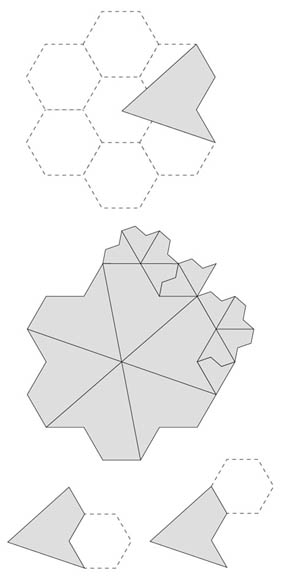Polyhex Prototile Conditions
Two requirements simplify the search for polyhex-based prototiles that allow f -tilings.
1. The generating polyhex must have 2-fold or 3-fold rotational symmetry.
* The reason 6-fold rotational symmetry is not allowed is discussed below, and other rotational symmetries do not occur in polyhexes.
* While polyhexes without rotational symmetry may be used, they generate no new prototiles, and therefore they do not need to be considered.
* Mirrored variants of polyhexes are not considered to generate distinct prototiles, as they would result in f-tilings that are an overall mirror of the f-tilings constructed from non-mirrored variants.
2. For a prototile generated by bisecting a polyhex, each dissecting line, which will form the long edge of the prototile, must originate and terminate at vertices of the polyhex and pass through the centroid of the polyhex. For a prototile generated by trisecting a polyhex, each dissecting line, which will form one long edge of the prototile, must run from the centroid of the polyhex to a vertex.
* The three trisecting lines are related to each other by rotations of 120 degrees about the centroid.
* The bisecting and trisecting lines (long edges of the prototile) must be longer than the short edges of the polyhex (short edges of the prototile).



* Below is the prototile generated by dissecting the smallest 6-fold rotationally symmetric polyhex into sixths. The prototile has 2 long edges and 3 short edges.
* Consistent arrangement of second-generation tiles results in some unmatched long edges.
* Prototiles generated from higher-order 6-fold rotationally-symmetric polyhexes will all have an odd number of short edges. Attempting to produce f-tilings based on such prototiles will always have the problem of unmatched long edges in the second generation.

Go to Fractal Tiling Compendium Home
Webmaster: Robert Fathauer; rob@tessellations.com






